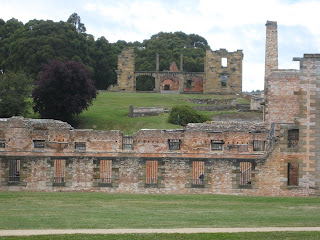 WEDNESDAY 4 - THURSDAY 5.1.2012: Made our way to the infamous Port Arthur and decided to tackle the Ghost Tour on the first night, followed by the day activities. We were fortunate to have excellent guides for both the evening and day tours, with both providing
WEDNESDAY 4 - THURSDAY 5.1.2012: Made our way to the infamous Port Arthur and decided to tackle the Ghost Tour on the first night, followed by the day activities. We were fortunate to have excellent guides for both the evening and day tours, with both providing a different view of Port Arthur. The Port Arthur penal station was established in 1830 as a timber-getting camp, using convict labour to produce sawn logs for government projects. From 1833 Port Arthur was used as a punishment station for repeat offenders from all the Australian colonies. The English prisoner reformer Jeremy Bentham designed a radical new Penitentiary at Pentonville in England, which he described as 'a machine for grinding rogues into honest men'. This became the model for Port Arthur. The cogs of this machine included discipline and punishment, religious and moral instruction, classification and separation, training and education.
a different view of Port Arthur. The Port Arthur penal station was established in 1830 as a timber-getting camp, using convict labour to produce sawn logs for government projects. From 1833 Port Arthur was used as a punishment station for repeat offenders from all the Australian colonies. The English prisoner reformer Jeremy Bentham designed a radical new Penitentiary at Pentonville in England, which he described as 'a machine for grinding rogues into honest men'. This became the model for Port Arthur. The cogs of this machine included discipline and punishment, religious and moral instruction, classification and separation, training and education. Not much different from the systems we have in place today! By 1840 more than 2000 convicts, soldiers and civil staff lived at Port Arthur, which by this time was a major industrial settlement. With the end of convict transportation to Van Diemen's Land in 1853, Port Arthur also became an institution for aging and physically and mentally ill convicts. The penal settlement finally closed in 1877 and many of its buildings were dismantled or destroyed in bushfires.
 |
| THE ISLE OF THE DEAD |
The Isle of the Dead - between 1833 and 1877 around 1100 people were buried at the settlement's cemetery. The Isle of the Dead is the final resting place for military and civil officers, their wives and children, and convicts.
 |
| VIEW FROM THE CRUISE TOUR |
Having climbed up hills and stairs, down dales and more stairs, we dragged our weary bodies to stay at the back of Nubeena Tasman Ex-Servicemans Club.
| JUNIOR MEDICAL OFFICER'S HOUSE 1848 |
 |
| GUARD TOWER 1835 |







No comments:
Post a Comment